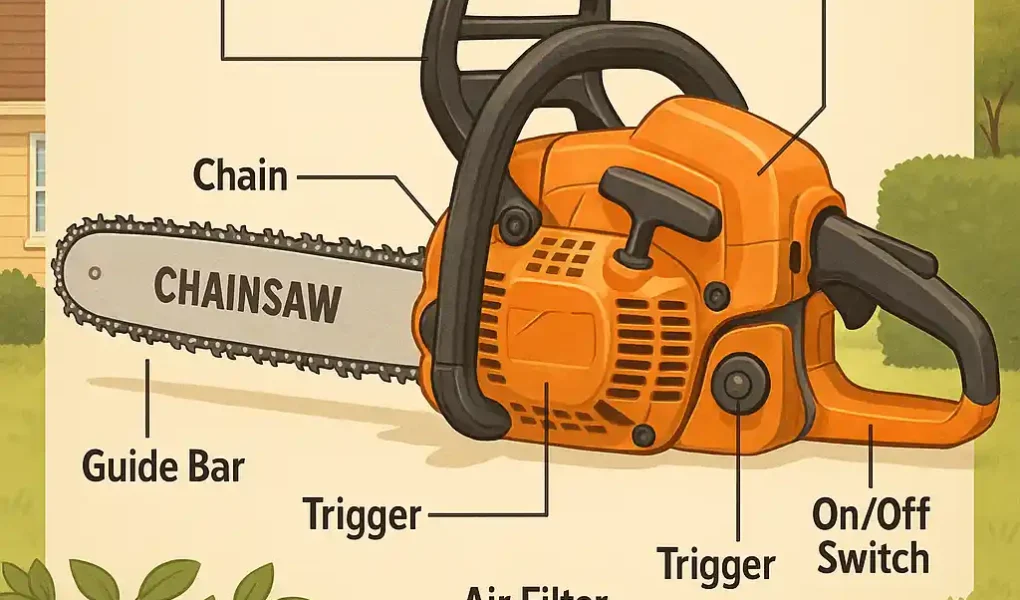A well-maintained chainsaw is crucial for tackling home improvement projects, from trimming overgrown trees near your house to cutting firewood for winter. Regular upkeep ensures your tool stays reliable for years of household use. Below are key parts to monitor and replace for optimal performance around your home.
The best part? You don’t need to be a mechanic to fix most of these issues. A quick swap of a worn-out part can have your saw running like new again. And if you’re missing anything, you can easily grab chainsaw parts online without any hassle.
Let’s break down the key parts that keep your chainsaw in top shape, and how to know when they need replacing.
The Chain (Protect Your Home from Dangerous Overgrowth)
A dull chain compromises safety and efficiency, making yard work laborious. Replace it when:
- Cutting takes longer despite effort
- Splintered edges appear instead of clean cuts
- The chain loosens repeatedly, even after adjustments
Home Fix: Match the new chain to your guide bar’s specifications. Secure it tightly, ensuring proper tension for safe operation around your property.
The Guide Bar (Avoid House Hazards with Proper Alignment)
A warped or grooved guide bar risks uneven cuts and chain derailment. Replace when:
- The chain slips off frequently
- Uneven wear or visible bends occur
- Cracks develop near the tip
Home Fix: Install a new bar, aligning oil holes for smooth lubrication. Rotate it regularly to prolong its life for household tasks.
The Spark Plug (Ensure Quick Starts for Emergencies)
A faulty spark plug leaves your saw useless during urgent home repairs. Replace it if:
- Starting requires excessive pulls
- The engine sputters or dies mid-cut
- The plug appears sooty or corroded
Home Fix: Use fresh, correctly gapped plugs and replace annually. Ethanol-free fuel prevents buildup, safeguarding your saw’s engine.
The Air Filter (Keep Your Saw Breathing for Heavy-Duty Home Projects)
Clogged filters reduce power, critical for demanding yard work. Address issues when:
- The saw overheats or emits black smoke
- Dust/debris block airflow
Home Fix: Clean foam filters with soapy water or replace paper filters. Inspect after dusty jobs to maintain peak performance for home use.
The Fuel Filter (Prevent Frustration During Household Chores)
A blocked fuel filter disrupts workflow. Replace it when:
- The saw starts but stalls
- Fuel flow seems restricted
Home Fix: Use fresh, stabilized gas to minimize gunk. Swap filters annually to avoid mid-task breakdowns.
The Carburetor (Maintain Reliability for Home Safety)
Old fuel clogs carburetors, risking erratic operation. Clean or replace if:
- RPMs fluctuate unpredictably
- Cleaning spark plugs/filters doesn’t help
Home Fix: Use carb cleaner for minor blockages. Upgrade to ethanol-free fuel to protect this critical component.
The Pull Cord (Avoid Exhausting Yard Work Sessions)
A snapped cord halts progress. Replace when:
- Fraying or breakage occurs
- The cord won’t retract
Home Fix: Rewind a new cord carefully, ensuring smooth pulls for stress-free starts.
The Chain Brake (Safeguard Your Home Projects)
A faulty brake risks injury during property maintenance. Test it:
- Before each use
- If the handle feels loose
Home Fix: Replace worn parts immediately. Never operate a saw without a functional brake.
Conclusion
Regular chainsaw maintenance keeps your home projects on track and prevents costly repairs. Stock replacement parts like chains, filters, and plugs to handle wear and tear efficiently. For homeowners, mastering simple fixes ensures your saw remains a reliable ally in yard upkeep. Check online retailers for parts, and always prioritize safety to protect your home and family.




